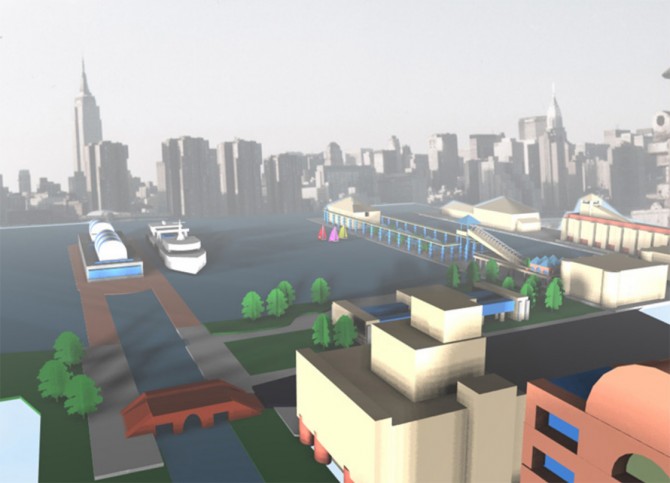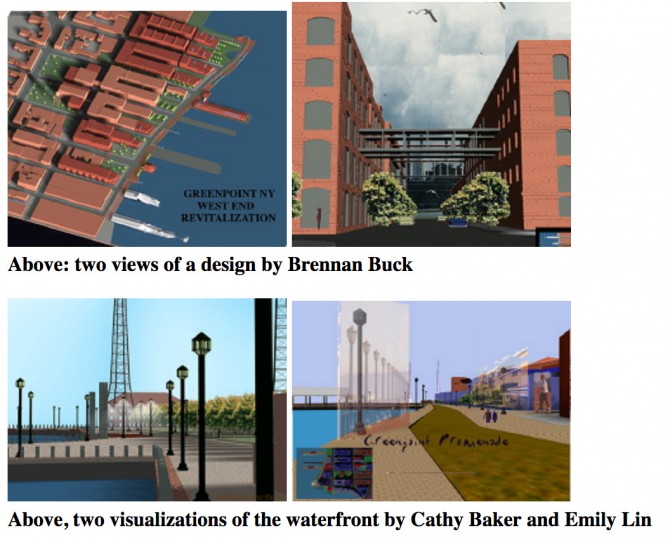Cornell students help neighborhood visualize designs for Greenpoint Terminal in Brooklyn
By Darryl Geddes
A waterfront recreation park, energy efficient glass-walled condos, a marketplace reminiscent of Boston's Fanueil Hall and a maritime museum are among the ideas presented by a group of Cornell students for the reuse of Greenpoint Terminal in Brooklyn, N.Y.
Undergraduate and graduate students in landscape architecture and city and regional planning developed their computer-generated design strategies for a group of citizens concerned over a new waterfront zoning being implemented by the New York City Planning Department for Greenpoint Terminal, a nearly 30-acre waterfront in the northern section of Brooklyn on the East River.
"These are some really wonderful and dynamic uses for Greenpoint," said Brooklyn resident Janice Lauletta, who attended an informal presentation of the designs last semester at Cornell. "The students have given us some interesting ideas about how Greenpoint might look and what uses might be best for the area."
Students traveled to Brooklyn last semester to get a feel for the neighborhood and assess the impact that new zoning would have on the area. "It was an excellent opportunity to immerse ourselves in the culture and increase our understanding of the community," said graduate assistant Mario Pangos, who accompanied the students on the road trip. "The visit to Greenpoint Terminal was extremely helpful to us as we planned future uses for the site."
Historically the Greenpoint Terminal project area was the site of ironworks and the ship-building industry (the Civil War ship Monitor was built here), lumber companies and warehousing.
"It's a classic case to study for students of urban design," said Professor Roger Trancik. "There's a well-established neighborhood in the area; there's commerce and a spectacular view of New York City. Planners have to make sure their proposals don't have a negative impact on the established communities around Greenpoint, while ensuring that these new uses are in keeping with a proper reuse of Greenpoint.
Finding reuse for Greenpoint Terminal is actually the final project for the Cornell architecture, art and planning course on Designing Cities in the Electronic Age taught by Trancik. This high-tech urban design studio course puts students in touch with the latest technology available to plan, plot and build cities. Students used software called "Form*Z," along with Adobe Photoshop, to model their waterfront makeovers. In the studio, students not only learn the principles of urban design but how to design cities electronically. The software allows students to generate images and merge computer images with photography and other archival images and information, such as maps and sketches. The software even enables one to see what types of shadows the 3 o'clock sun would cast on a downtown plaza, and it's all done in virtual 3-D.
"Today, one has to tackle the technology while at the same time learning all there is about urban design," Trancik said. "The technology has enabled students to see instantly whether they have applied their knowledge of urban design correctly. It's extremely important to integrate educational content with skill development in using this or any software."
Cornell's future plans in the area of urban design include the development of a public urban design education initiative that would include a digital outreach program in New York City. Under the program, students, as part of their course work, would provide on-site digital workshops and presentations in various neighborhoods where major redevelopment projects are being undertaken.
"This activity would benefit our students immensely," said Trancik, "as well as provide community groups and other organizations greater involvement in the urban design process."
Get Cornell news delivered right to your inbox.
Subscribe
